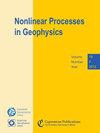Existence and influence of mixed states in a model of vegetation patterns
IF 2.4
4区 地球科学
Q3 GEOSCIENCES, MULTIDISCIPLINARY
引用次数: 0
Abstract
Abstract. The Rietkerk vegetation model is a system of partial differential equations, which has been used to understand the formation and dynamics of spatial patterns in vegetation ecosystems, including desertification and biodiversity loss. Here, we provide an in-depth bifurcation analysis of the vegetation patterns produced by Rietkerk's model, based on a linear stability analysis of the homogeneous equilibrium of the system. Specifically, using a continuation method based on the Newton–Raphson algorithm, we obtain all the main heterogeneous equilibria for a given size of the domain. We confirm that inhomogeneous vegetated states can exist and be stable, even for a value of rainfall for which no vegetation exists in the non-spatialized system. In addition, we evidence the existence of a new type of equilibrium, which we call “mixed state”, in which the equilibria are always unstable and take the form of a mix of two equilibria from the main branches. Although these equilibria are unstable, they influence the dynamics of the transitions between distinct stable states by slowing down the evolution of the system when it passes close to it. Our approach proves to be a helpful way to assess the existence of tipping points in spatially extended systems and disentangle the fate of the system in the Busse balloon. Overall, our findings represent a significant step forward in understanding the behaviour of the Rietkerk model and the broader dynamics of vegetation patterns.植被模式模型中混合状态的存在及其影响
摘要Rietkerk 植被模型是一个偏微分方程系统,已被用于理解植被生态系统空间格局的形成和动态变化,包括荒漠化和生物多样性丧失。在此,我们基于系统同质平衡的线性稳定性分析,对 Rietkerk 模型产生的植被模式进行了深入的分岔分析。具体来说,我们使用基于牛顿-拉斐森算法的延续方法,得到了给定域大小的所有主要异质平衡。我们证实,即使在非空间化系统中不存在植被的降雨量值,非均质植被状态也可以存在并保持稳定。此外,我们还证明了一种新型平衡的存在,我们称之为 "混合状态",在这种状态下,平衡总是不稳定的,其形式是两个主要分支平衡的混合。虽然这些平衡状态并不稳定,但当系统接近这些平衡状态时,它们会减慢系统的演化速度,从而影响不同稳定状态之间的过渡动力学。事实证明,我们的方法有助于评估空间扩展系统中是否存在临界点,并厘清布塞气球中系统的命运。总之,我们的研究结果标志着我们在理解 Rietkerk 模型的行为和植被模式的更广泛动态方面迈出了重要一步。
本文章由计算机程序翻译,如有差异,请以英文原文为准。
求助全文
约1分钟内获得全文
求助全文
来源期刊

Nonlinear Processes in Geophysics
地学-地球化学与地球物理
CiteScore
4.00
自引率
0.00%
发文量
21
审稿时长
6-12 weeks
期刊介绍:
Nonlinear Processes in Geophysics (NPG) is an international, inter-/trans-disciplinary, non-profit journal devoted to breaking the deadlocks often faced by standard approaches in Earth and space sciences. It therefore solicits disruptive and innovative concepts and methodologies, as well as original applications of these to address the ubiquitous complexity in geoscience systems, and in interacting social and biological systems. Such systems are nonlinear, with responses strongly non-proportional to perturbations, and show an associated extreme variability across scales.
 求助内容:
求助内容: 应助结果提醒方式:
应助结果提醒方式:


